Commensal microorganisms Study guides, Class notes & Summaries
Looking for the best study guides, study notes and summaries about Commensal microorganisms? On this page you'll find 147 study documents about Commensal microorganisms.
Page 2 out of 147 results
Sort by
![Immunology Chapter 1-4 Exam Latest I]Update Graded A+](/docpics/5738440/6681529cd27fd_5738440_121_171.jpeg)
-
Immunology Chapter 1-4 Exam Latest I]Update Graded A+
- Exam (elaborations) • 9 pages • 2024
-
- $11.09
- + learn more
Immunology Chapter 1-4 Exam Latest Immunology - the study of physiological mechanism humans and other animals use to defend their bodies from invasion by other organisms Immune - originally used to describe those who had surived a disease and did not suffer from it when faced with it again Infectious disease - disease cause by a microorganism Immune system - the collection of cells and physiological mechanisms the human body utilizes to fight infections Vaccination; imm...
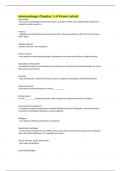
-
Immunology Chapter 1-4 Exam Latest
- Exam (elaborations) • 9 pages • 2024
-
- $10.99
- + learn more
Immunology Chapter 1-4 Exam Latest Immunology - the study of physiological mechanism humans and other animals use to defend their bodies from invasion by other organisms Immune - originally used to describe those who had surived a disease and did not suffer from it when faced with it again Infectious disease - disease cause by a microorganism Immune system - the collection of cells and physiological mechanisms the human body utilizes to fight infections Vaccination; immu...
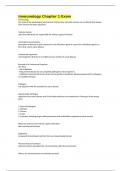
-
Immunology Chapter 1 Exam
- Exam (elaborations) • 9 pages • 2024
-
- $10.69
- + learn more
Immunology Chapter 1 Exam Immunology the study of the physiological mechanisms that humans and other animals use to defend their bodies from invasion by other organisms Immune System cells that collectively are responsible for defense against infection Vaccination/Immunization prevention of disease by prior exposure to the infectious agent or a part of an infectious agent in a form that cannot cause disease Commensal Organisms microorganisms that live in a healthy human and d...
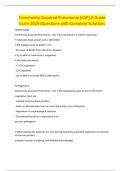
-
Community Acquired Pneumonia (CAP) A Grade Exam 2024|Questions with Complete Solutions
- Exam (elaborations) • 15 pages • 2024
- Available in package deal
-
- $13.19
- + learn more
Epidemiology Community-Acquired Pneumonia - Ans • An estimated 5.6 million cases/year • Estimated total annual cost is $10 billion • 6th leading cause of death in U.S. - #1 cause of death from infectious diseases • Up to 80% of treatment is outpatient • Mortality rate varies - <1-5% outpatient - 12% inpatient - Up to 40% in critically ill/ICU admissions Pathogenesis Community-Acquired Pneumonia - Ans • Microorganisms gain access to the lower respiratory tract via: - I...
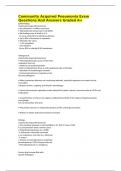
-
Community Acquired Pneumonia Exam Questions And Answers Graded A+
- Exam (elaborations) • 8 pages • 2024
-
Available in package deal
-
- $9.69
- + learn more
Community Acquired Pneumonia Exam Questions And Answers Graded A+ Epidemiology Community-Acquired Pneumonia • An estimated 5.6 million cases/year • Estimated total annual cost is $10 billion • 6th leading cause of death in U.S. - #1 cause of death from infectious diseases • Up to 80% of treatment is outpatient • Mortality rate varies - <1-5% outpatient - 12% inpatient - Up to 40% in critically ill/ICU admissions Pathogenesis Community-Acquired Pneumonia • Microor...
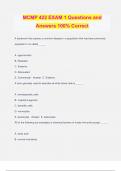
-
MCMP 422 EXAM 1 Questions and Answers 100% Correct
- Exam (elaborations) • 44 pages • 2024
- Available in package deal
-
- $13.49
- + learn more
MCMP 422 EXAM 1 Questions and Answers 100% Correct A bacterium that causes a common disease in a population that has been previously exposed to it is called _____. A. opportunistic B. Resistant C. Endemic D. Attenuated E. Commensal - Answer- C. Endemic A term generally used to describe all white blood cells is _____. A. hematopoietic cells B. myeloid progenitor C. dendritic cells D. monocytes E. leukocytes - Answer- E. leukocytes All of the following are examples of chemical barri...
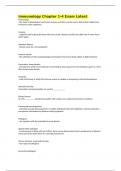
-
Immunology Chapter 1-4 Exam Latest
- Exam (elaborations) • 9 pages • 2024
-
- $10.59
- + learn more
Immunology Chapter 1-4 Exam Latest Immunology - the study of physiological mechanism humans and other animals use to defend their bodies from invasion by other organisms Immune - originally used to describe those who had surived a disease and did not suffer from it when faced with it again Infectious disease - disease cause by a microorganism Immune system - the collection of cells and physiological mechanisms the human body utilizes to fight infections Vaccination; im...
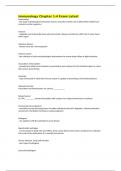
-
Immunology Chapter 1-4 Exam Latest
- Exam (elaborations) • 9 pages • 2024
-
- $10.69
- + learn more
Immunology Chapter 1-4 Exam Latest Immunology - the study of physiological mechanism humans and other animals use to defend their bodies from invasion by other organisms Immune - originally used to describe those who had surived a disease and did not suffer from it when faced with it again Infectious disease - disease cause by a microorganism Immune system - the collection of cells and physiological mechanisms the human body utilizes to fight infections Vaccination; immu...
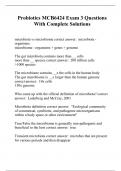
-
Probiotics MCB6424 Exam 3 Questions With Complete Solutions
- Exam (elaborations) • 18 pages • 2023
-
- $12.99
- + learn more
microbiota vs microbiome correct answer: microbiota - organisms microbiome - organisms + genes + genome The gut microbiota contains more than __ cells more than __ species correct answer: 200 trillion cells >1000 species The microbiome contains __x the cells in the human body The gut microbiome is __x larger than the human genome correct answer: 10x cells 150x genome Who came up with the official definition of microbiota? correct answer: Lederberg and McCray, 2001 Microbi...
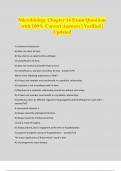
-
Microbiology Chapter 14 Exam Questions with 100% Correct Answers | Verified | Updated
- Exam (elaborations) • 11 pages • 2024
- Available in package deal
-
- $11.49
- + learn more
Microbiology Chapter 14 Exam Questions with 100% Correct Answers | Verified | Updated A commensal bacterium A) does not infect its host. B) may also be an opportunistic pathogen. C) is beneficial to its host. D) does not receive any benefit from its host. E) is beneficial to, and does not infect, its host - answerB Which of the following statements is TRUE? A) At least one member must not benefit in a symbiotic relationship. B) A parasite is not in symbiosis with its host. C) Members...

How did he do that? By selling his study resources on Stuvia. Try it yourself! Discover all about earning on Stuvia


